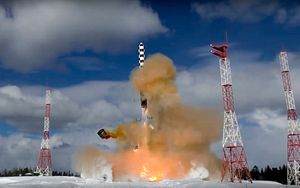A Russian defense industry source told local state-owned media on October 31 that serial production of the new intercontinental-range ballistic missile (ICBM), the super-heavy thermonuclear-armed RS-28 Sarmat (NATO designation: SS-X-30 Satan 2), will begin in 2021.
The Russian Strategic Rocket Forces are expected to receive the first regiment, consisting of two silo-based RS-28 ICBMs, in the same year. “The deadline for completing the Sarmat’s flight tests and authorizing it for service is 2021. Serial production is due to begin in the same year. The first regiment – two silo-launched Sarmats and a command center – will enter duty then, too,” the source said.
The first Strategic Missile Force unit to receive the new ICBM will reportedly be a regiment of the 62nd Missile Division, deployed in Uzhur, part of the 33rd Guards Missile Army, headquartered in Omsk in southwestern Siberia. “[T]he regiment will first receive two RS-28 ICBMs, and is expected to deploy a total of six RS-28s. (Missile regiments consist of up to 10 missiles and around 400 military personnel.),” I reported in March.
It unclear when the regiment will receive the additional four ICBMs.
In total, seven regiments – with six missiles in a regiment plus one ten-missile regiment for a total count of 46 RS-28s – will be deployed and split up between two missile divisions based in Dombarovskiy and Uzhur. The RS-28 is slated to gradually replace the Strategic Missile Forces’ arsenal of Soviet-era RS-36M2 Voyevoda (NATO designation: SS-18 Satan) ICBMs by the middle of the 2020s.
(The missile division based in Dombarovskiy in the Orenburg region in the south Urals, will also receive the first regiment of UR-100NUTTkHs (NATO reporting name: SS-19 Stiletto) armed with the Avangard hypersonic boost-glide warhead.)
The first flight test of the RS-28 is scheduled for early 2019, which will involve the launching of the missile’s second- and third-stage engines. As I wrote earlier this month:
Russia conducted the third and last ejection test of the RS-28 Sarmat at the Plesetsk space center, located in Arkhangelsk Oblast approximately 800 kilometers north of the Russian capital, Moscow, in May 2018. This was preceded by ejection tests in March 2018 and December 2017 respectively. The tests involved the ignition of the Sarmat’s first-stage and booster engine, likely the PDU-99 — a modified version of the RD-274 liquid rocket engine used on the RS-36M2 Voyevoda (NATO designation: SS-18 Satan).
The RS-28 program has been plagued by delays including multiple postponements of ejections tests. It remains doubtful that the ICBM will be operational by 2021. Originally, it was assumed that the first missile would be delivered to the Strategic Missile Forces in 2015. As of January 2017, the Strategic Missile Forces have a total of 286 ICBMs, armed with a total of 958 warheads, deployed.































